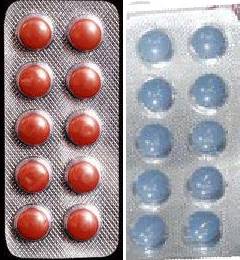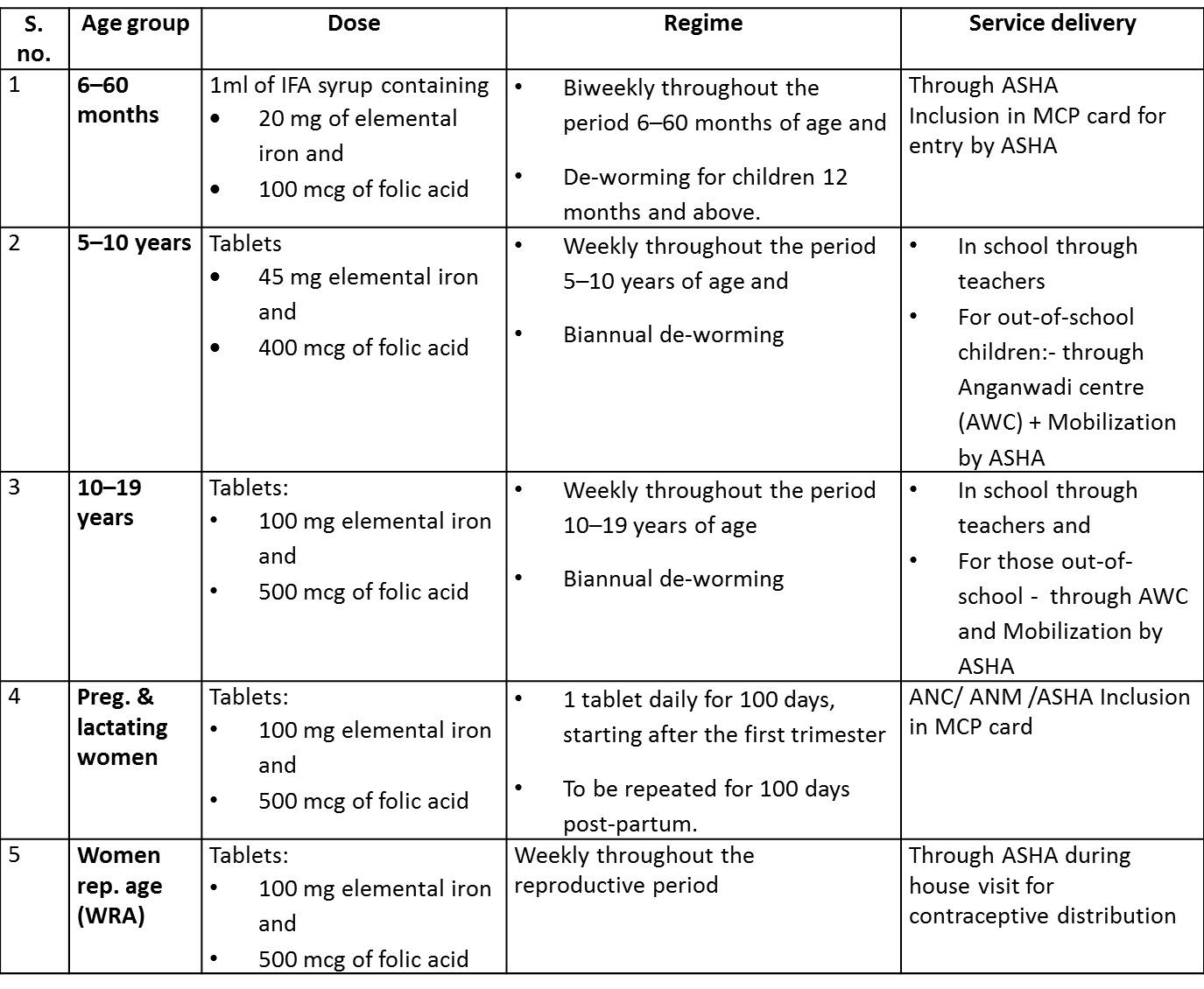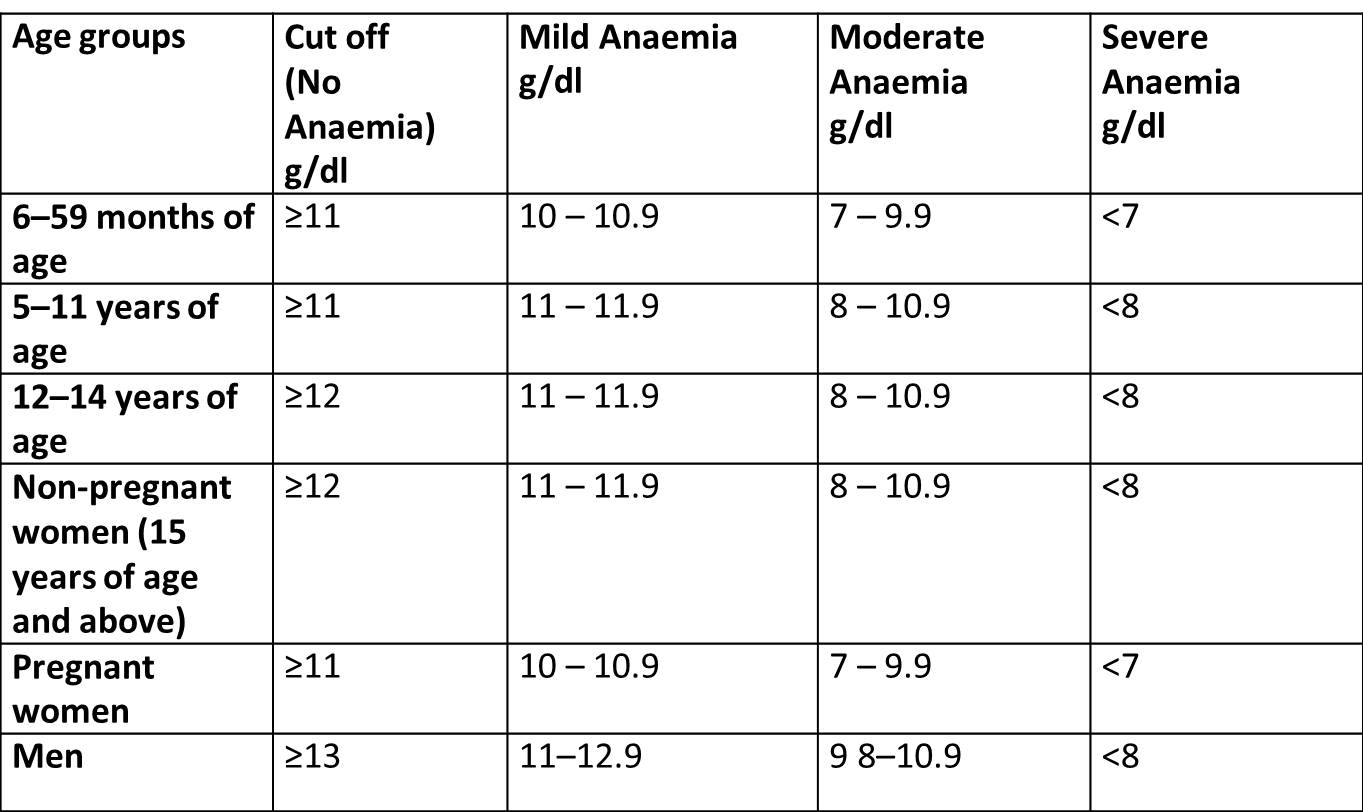
Against which diseases are they recommended?
They are recommended for prevention and treatment of anemia across the life cycle i.e. 6months – 5 yr, 5 – 10 yr, 10 – 19 yr., women in reproductive age, during pregnancy and lactation.
Mention some iron rich foods.
• Heme iron: Liver, meat, poultry, and fish.
• Nonheme iron: Green leafy vegetables, legumes, cereals, nuts and oilseeds, jaggery, and dried fruits.
Enumerate the anatomic sites to be examined for detecting pallor.
• Lower palpebral conjunctiva
• Tongue and oral mucosa
• Nails
• Palms of hands
What is "Iron Plus Initiative"?
Iron Plus initiative was launched to integrate the existing IFA supplementation programmes for
– pregnant and lactating women and;
– children in the age group of 6–60 months and
Also to include additional age groups for IFA supplementation – thereby providing prevention and treatment of anemia across the life cycle i.e.
1. 6months – 5 yr.
2. 5 – 10 yr.
3. 10 – 19 yr.
4. Women in reproductive age and
5. During pregnancy and lactation.
What is the frequency of IFA administration for the beneficiary age groups?
– Bi-weekly iron supplementation for preschool children 6 months to 5 years
– Weekly supplementation for children from 1st to 5th grade in Govt. & Govt. Aided schools
– Weekly supplementation for out of school children (5–10 years) at Anganwadi Centres
– Weekly supplementation for adolescents (10–19 years)
– Daily supplementation for 100 days for Pregnant and lactating women
– Weekly supplementation for women in reproductive age
The dose and frequency of IFA supplementation for various age groups has been summarized in the following table
Note: The IFA supplementation programme is a preventive measure and should not be confused with treatment of iron deficiency anemia (IDA)
In addition to the above preventive regimens, therapeutic regimens have also been developed for these groups. These are to be given if anemia is detected
ASHA is to be suitably incentivized for provision IFA supplements to beneficiary
What is the recommended strength of the tablets for a pregnant woman under the National program?
These tablets contain 100 mg of elemental iron and 500 µg of folic acid.
Mention the prophylactic and therapeutic doses recommended for a pregnant lady, under the National program.
The recommended dose is as follows:
• For prophylaxis (prevention of anemia): One tablet once daily for a period of 100 days, starting after 12 weeks (first trimester) of pregnancy. Hence a total of 100 tablets are to be dispensed.
• For treating anemia: One tablet twice a day for 100 days, starting after the first trimester. Hence a total of 200 tablets are to be dispensed.
After starting the therapeutic dose, Hb levels should be reassessed at monthly intervals.
If on testing, Hb has come up to normal level, the prophylactic dose can be resumed.
If it does not rise in spite of the administration of 2 tablets of IFA daily and dietary supplementation, the woman should be referred to the next higher health facility for further management.
What advice would you give to a recipient consuming the IFA tablet?
• The recipient of IFA tablet should consume the tablet after meals to avoid gastric discomfort and nausea.
• She may pass black stools after consuming IFA tablets.
• She may experience loose stools or constipation for some time but this will settle after some days.
• Avoid taking the tablets with tea, coffee or milk as these may interfere with absorption of iron.
• Calcium tablets should not be taken at the same time as calcium inhibits absorption of iron.
• In case of pregnant or lactating woman: She must consume the tablets daily.
Why the IFA tablets for school children, blue in colour?
It is a conscious effort under WIFS programme to position the supplementation positively to reach out to both boys and girls and ensure compliance. IFA tablet has been made blue (‘Iron ki nili goli’) to distinguish it from the red IFA tablet for pregnant and lactating women
What is ‘Weekly Iron and Folic acid supplementation (WIFS)’?
Weekly Iron and Folic acid supplementation programme, under the iron plus initiative, is for adolescents
Also known as WIFS-Blue campaign.
Nodal agency- Ministry of H&FW
Beneficiaries-
Adolescent girls/boys enrolled in school, 6th- 12th std. (Min of Education)
Adolescent girls not enrolled in schools (Min of Social Welfare): they are to be approached through anganwadis
Services
IFA tablet to target population on weekly basis on a fixed day (Monday) for 52 weeks annually
Bi-annual deworming (February and August)
Teachers and AWWs will supervise the ingestion of the IFA tablet by the beneficiaries.
What is the cut-off hemoglobin level for diagnosing anemia?
Following table lists the cut – offs in different age groups for diagnosing anemia:
Why do the beneficiary age groups begin from 6 months of age?
The onset of anaemia in young children is generally after 6 months of age. Before this, iron in breast milk is sufficient to meet the needs of a breastfed child.
Iron from breast milk is in a form that is more easily bio-available to the young child.
Therefore the incidence of anaemia increases from 6–8 months till the child is 1 year old. In India, diets for children in the age group 6–23 months are predominantly plant-based and provide insufficient amounts of micronutrients to meet the recommended nutrient intakes.
Are there any contraindications for IFA prophylaxis?
Prophylaxis with iron should be withheld in case of
• Acute illness (fever, acute diarrhoea, pneumonia etc.)
• Severe acute malnutrition (SAM)
• Known case of haemoglobinopathy
• History of repeated blood transfusion.
What is the main cause of Iron deficiency anemia (IDA) in children?
Iron requirements increase during the period of active growth in childhood, especially from 6 months to 3 years. In infancy, iron deficiency is most often the result of lack of exclusive breast feeding and use of un-supplemented milk diets.
Milk products are very poor sources of iron and prolonged breast or bottle feeding of the infant without complementary feeds after 6 months of age frequently lead to iron deficiency unless there is iron supplementation.
Iron requirements are proportionately greater in premature and underweight babies. In older children, a predominantly milk and cereal based diet and food fads can also lead to IDA.
Why is deworming recommended along with iron prophylaxis?
Helminths such as hookworm and flukes cause chronic blood loss and consequently iron loss from the body, resulting in the development of anaemia. A hookworm burden of 40–160 worms (depending on the iron status of the host) may result in IDA.
Mention some foods which enhance the absorption of iron.
1. Haem iron,
• present in meat, poultry, fish, and seafood
2. Ascorbic acid or vitamin C,
• present in
• fruits
• juices
• potatoes and some other tubers and
• other vegetables such as green leaves, cauliflower, and cabbage
3. Fermented or germinated food
Mention some inhibitors of iron absorption.
1. Cereal bran, cereal grains, high-extraction flour, legumes, nuts, and seeds
2. Tea, coffee, cocoa, herbal infusions in general, certain spices (e.g. oregano)
3. Calcium, particularly from milk and milk products
Mention some other measures to prevent anaemia in children
Besides the provision of micronutrient supplements, the following measures need to be taken simultaneously as long-term measures to prevent IDA in children:
• Promotion of exclusive breastfeeding for the first 6 months of life
• Appropriate and adequate complementary feeding with iron rich foods till 2 years of age
• Dietary diversification to include foods rich in absorbable vitamins and minerals
• Increasing the bioavailability of iron in usual diets by altering meal patterns to increase enhancers and lower inhibitors of iron absorption
• Diagnosis and control and treatment of parasitic infections
Screening of target groups for moderate/severe anaemia and referring these cases to an appropriate health facility for management of anaemia is recommended in addition to iron supplementation.iron + document
What is the recommended daily allowance of iron during pregnancy?
RDA for pregnant lady—35 mg per daypark nut
Reference:
1. Guidelines for Control of Iron Deficiency Anaemia; Adolescent Division Ministry of Health and Family Welfare Government of India, 2013
2. Park K. Nutrition and Health. In: Park's Textbook of Preventive and Social Medicine, 24th ed. Jabalpur, India: M/S Banarasidas Bhanot Publishers; 2017.
3. Chapter 1-Maternal and Child Health; In: Mastering Practicals – Community Medicine. 2nd ed. Eds. Tiwari P, Tiwari S. Lippincott Williams & Wilkins; Wolters Kluwer, New Delhi
5-Page ANC History Taking Format: https://ihatepsm.com/blog/5-page-anc-history-taking-format-essential-gui...
Pallor and its Grading: https://ihatepsm.com/blog/pallor-and-its-grading
Why ANC History Taking Matters?: https://ihatepsm.com/blog/why-anc-history-taking-matters
#Obstetric index (GPAL) in Antenatal Case History: https://ihatepsm.com/blog/obstetric-index-gpal-antenatal-case-history
#Decoding Gravida and Para: Terms in Antenatal History Taking: https://ihatepsm.com/blog/decoding-gravida-and-para-terms-antenatal-hist...
#Duration of Pregnancy: Understanding the Trimesters and Gestational Age Categories: https://ihatepsm.com/blog/duration-pregnancy-understanding-trimesters-an...
#Calculation of Expected Date of Delivery (EDD) and Period of Gestation (POG): https://ihatepsm.com/blog/calculation-expected-date-delivery-edd-and-per...
#Antenatal Care and Case Booking: https://ihatepsm.com/blog/antenatal-care-and-case-booking
#Clinical Significance of Antenatal History Components (Socio-Demographic components): https://ihatepsm.com/blog/clinical-significance-antenatal-history-compon...
Antenatal History Taking: Significance of Clinical Components: https://ihatepsm.com/blog/antenatal-history-taking-significance-clinical...
Trimester-wise History Taking in Antenatal Care: FIRST Trimester: https://ihatepsm.com/blog/trimester-wise-history-taking-antenatal-care-f...
Trimester-wise History Taking in Antenatal Care: SECOND Trimester: https://ihatepsm.com/blog/trimester-wise-history-taking-antenatal-care-s...
Trimester-wise History Taking in Antenatal Care: THIRD Trimester: https://ihatepsm.com/blog/trimester-wise-history-taking-antenatal-care-t...
Trimester-wise History Taking in Antenatal Care: A Comprehensive Guide (all 3 trimesters): https://ihatepsm.com/blog/trimester-wise-history-taking-antenatal-care-c...
Components of Birth Preparedness and Complication Readiness (BPCR): https://ihatepsm.com/blog/components-birth-preparedness-and-complication...
BPCR in brief: https://ihatepsm.com/blog/%E2%80%98birth-preparedness-and-complication-r...
Specific Health Protection during Antenatal Visits: https://ihatepsm.com/blog/specific-health-protection-during-antenatal-vi...
